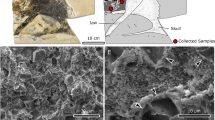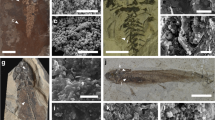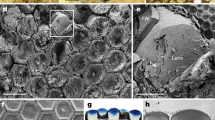Abstract
SEVERAL years ago, I described1 the discovery of crystallized organic pigments (‘fringelite’) in a fossil crinoid (Millericrinus) of upper Jurassic age. Additional specimens have now been collected at the two original locations (Fringeli and Liesberg, both in north-western Switzerland). The pigments are isolated by solvent extraction and separated by repetitive chromatography and fractional crystallization. Six pigments (fringelite A–F) have been isolated : additional pigments remaining in the fossil after exhaustive extraction with pyridine can be dissolved in concentrated sulphuric acid in which they exhibit an absorption spectrum similar to that of the more soluble fringelites. All these pigments are similar in respect to their absorption spectra, the colour of their solutions (red in organic solvents, green in sulphuric acid), the formation of green, insoluble sodium salts and the ease with which acetyl- and benzoyl-derivatives are formed. In all these properties the fringelites strongly resemble extended quinones of the type of aphin2 or hypericin3. They even give the characteristic aphin-reaction, a blue(-violet) colour, on treatment with acetic anhydride containing a small amount of sulphuric acid.
This is a preview of subscription content, access via your institution
Access options
Subscribe to this journal
Receive 51 print issues and online access
$199.00 per year
only $3.90 per issue
Buy this article
- Purchase on Springer Link
- Instant access to full article PDF
Prices may be subject to local taxes which are calculated during checkout
Similar content being viewed by others
References
Blumer, M., Mikrochemie, 36/37, 1048 (1951).
Brown, R. R., Calderbank, A., Johnson, A. W., Joshi, B. S., Quayle, J. R., and Todd, A. R., J. Chem. Soc., 959 (1955).
Brockman, H., and Muxfeldt, H., Naturwiss., 40, 411 (1953).
Calderbank, A., Johnson, A. W., and Todd, A. R., J. Chem. Soc., 1285 (1954).
Clar, E., Ber., 72, 1645 (1939). Brown, R. R., Johnson, A. W., Quayle, J. R., and Todd, A. R., J. Chem. Soc., 107 (1954).
Dimelow, E. J., Nature, 182, 812 (1958).
Author information
Authors and Affiliations
Rights and permissions
About this article
Cite this article
BLUMER, M. Pigments of a Fossil Echinoderm. Nature 188, 1100–1101 (1960). https://doi.org/10.1038/1881100b0
Issue Date:
DOI: https://doi.org/10.1038/1881100b0
This article is cited by
-
Lipid biomarkers: molecular tools for illuminating the history of microbial life
Nature Reviews Microbiology (2022)
-
Personal account: Heinz Falk’s contributions to geosciences
Monatshefte für Chemie - Chemical Monthly (2019)
Comments
By submitting a comment you agree to abide by our Terms and Community Guidelines. If you find something abusive or that does not comply with our terms or guidelines please flag it as inappropriate.



